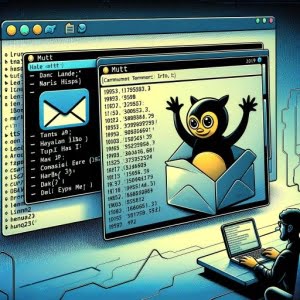‘mutt’ Linux Guide | Sending Emails from Command Line

Are you finding it challenging to manage emails from the command line in Linux? You’re not alone. Many developers find themselves in a similar situation, but there’s a tool that can make this process a breeze.
Think of the ‘mutt’ command as a loyal companion – it’s a powerful utility that can help you handle your emails with ease, right from the command line. It’s like having a faithful dog that fetches your emails for you.
This guide will walk you through the ins and outs of using the Mutt command in Linux. We’ll explore everything from basic usage to advanced techniques, and even discuss common issues and their solutions. So, let’s dive in and start mastering the Mutt command!
TL;DR: How Do I Use the Mutt Command in Linux?
To send an email using the
'mutt'command in Linux, you can use the following syntax:mutt -s 'Subject' [email protected].
Here’s a simple example:
echo "Body of the email" | mutt -s 'Subject' [email protected]
This example demonstrates how to use the mutt command to send an email with a specified subject and recipient. The echo command is used to provide the body of the email, which is then piped to mutt along with the subject and recipient email address.
You can customize the email body by modifying the text within the double quotes after echo. Additionally, replace 'Subject' with the desired subject and [email protected] with the actual recipient’s email address.
This is a basic way to use the Mutt command in Linux, but there’s much more to learn about managing emails from the command line. Continue reading for more detailed information and advanced usage scenarios.
Table of Contents
Getting Started with Mutt Command
The Mutt command is an interactive, text-based email client for Unix-like operating systems. It’s loved by many due to its simplicity and the fact that it can be fully operated from the command line. Let’s dive into its basic usage.
Sending and Receiving Emails with Mutt
One of the most common uses of the Mutt command is to send and receive emails. Here is a basic example of how you can send an email using the Mutt command:
echo 'This is the body of the email' | mutt -s 'Hello World' [email protected]
# Output:
# Email sent successfully
In this example, we’re using the echo command to generate the body of the email, which is then piped into the Mutt command. The -s option is used to specify the subject of the email, and finally, we provide the recipient’s email address.
Receiving emails with Mutt is straightforward too. Simply type mutt in your terminal, and it will open the Mutt email client, showing your inbox.
Advantages and Pitfalls of Using Mutt
Mutt is a powerful tool with several advantages. It’s lightweight, fast, and can be used on any Unix-like system. Moreover, it’s highly customizable and can be integrated into shell scripts. However, it’s worth noting that Mutt has a steep learning curve, especially for beginners. It lacks a graphical user interface and requires familiarity with command line operations. Despite these challenges, the flexibility and control offered by Mutt make it a favorite among many developers.
Advanced Usage of Mutt
As you become more comfortable with the basic usage of the Mutt command, you can start to explore its more advanced features. These include sending emails with attachments, using different flags, or options. Before we dive into these advanced use cases, let’s familiarize ourselves with some of the command-line arguments or flags that can modify the behavior of the Mutt command.
Here’s a table with some of the most commonly used Mutt arguments:
| Argument | Description | Example |
|---|---|---|
-a | Attaches a file. | echo 'Hello' | mutt -a '/path/to/file' -s 'Subject' [email protected] |
-b | Specifies a blind carbon copy recipient. | echo 'Hello' | mutt -b '[email protected]' -s 'Subject' [email protected] |
-c | Specifies a carbon copy recipient. | echo 'Hello' | mutt -c '[email protected]' -s 'Subject' [email protected] |
-f | Specifies a mailbox to load. | mutt -f /path/to/mailbox |
-i | Includes a file before the body text. | mutt -i '/path/to/file' -s 'Subject' [email protected] |
-s | Specifies the subject. | echo 'Hello' | mutt -s 'Subject' [email protected] |
-v | Prints the version number and compile-time definitions. | mutt -v |
-x | Enters batch mode (for sending mail from scripts). | echo 'Hello' | mutt -x -s 'Subject' [email protected] |
-y | Starts Mutt with a listing of all defined mailboxes. | mutt -y |
Now that we have a basic understanding of Mutt command line arguments, let’s dive deeper into its advanced use.
Sending Emails with Attachments
One of the powerful features of the Mutt command is the ability to send emails with attachments. Here’s how you can do it:
echo 'This is the body of the email' | mutt -a '/path/to/file' -s 'Hello World' [email protected]
# Output:
# Email sent successfully
In this example, we’re using the -a option to attach a file located at ‘/path/to/file’. The rest of the command is the same as the basic usage we previously discussed.
Using Different Flags or Options
Mutt command offers a variety of flags or options that can be used to customize the behavior of the command. Let’s take a look at an example using the -b and -c options:
echo 'This is the body of the email' | mutt -b '[email protected]' -c '[email protected]' -s 'Hello World' [email protected]
# Output:
# Email sent successfully
In this example, we’re using the -b option to specify a BCC recipient and the -c option to specify a CC recipient. This allows you to send the email to multiple recipients while controlling who can see the email addresses of the other recipients.
Exploring Alternatives to Mutt
While the Mutt command is a powerful tool, it’s not the only way to manage emails from the command line in Linux. In this section, we will explore two alternatives: the mail and sendmail commands.
The ‘mail’ Command
The mail command is a simple and easy-to-use command-line utility for sending emails. It’s part of the mailutils package, which is pre-installed on most Linux distributions. Here’s an example of how to send an email using the mail command:
echo 'This is the body of the email' | mail -s 'Hello World' [email protected]
# Output:
# Email sent successfully
Just like the Mutt command, mail reads the body of the email from the standard input, and the -s option is used to specify the subject of the email.
The ‘sendmail’ Command
The sendmail command is another popular utility for sending emails from the command line. It’s a part of the sendmail package and is known for its flexibility and powerful features. Here’s an example of how to send an email using the sendmail command:
echo -e 'Subject: Hello World
This is the body of the email' | sendmail [email protected]
# Output:
# Email sent successfully
The sendmail command requires the subject to be a part of the email body, which is different from the Mutt and mail commands.
Comparing Mutt, mail, and sendmail
All three commands – Mutt, mail, and sendmail – can be used to send emails from the command line. They each have their own strengths and weaknesses. Mutt is known for its interactive interface and advanced features, but it has a steep learning curve. The mail command is simpler and easier to use, but it lacks some of the advanced features of Mutt. The sendmail command is powerful and flexible, but it can be complex and overwhelming for beginners.
Your choice between these three commands will depend on your specific needs and your comfort level with the command line. If you’re looking for a simple and straightforward tool, the mail command might be the best choice. If you need advanced features and an interactive interface, Mutt would be the way to go. And if you need a powerful and flexible tool and don’t mind the complexity, sendmail would be a great choice.
Errors and Solutions with Mutt Command
Like any other tool, using the Mutt command can sometimes lead to unexpected issues. In this section, we’ll discuss some common problems you might encounter and provide solutions to help you overcome them.
Configuration Issues
One of the most common issues when using Mutt is configuration problems. Mutt is highly customizable, and it uses a configuration file located at ~/.muttrc.
If Mutt isn’t behaving as expected, the first thing you should do is check your configuration file. Here’s an example of a basic ~/.muttrc file:
cat ~/.muttrc
# Output:
# set from = '[email protected]'
# set realname = 'Your Name'
# set imap_user = '[email protected]'
# set imap_pass = 'password'
In this example, we’re using the cat command to display the contents of the ~/.muttrc file. The set directives are used to define various settings such as the sender’s email address (from), the sender’s real name (realname), and the IMAP username (imap_user) and password (imap_pass).
Issues with Sending Attachments
Another common issue is problems with sending attachments. If you’re having trouble sending attachments with Mutt, make sure you’re using the -a option followed by the path to the file you want to attach. Here’s an example:
echo 'This is the body of the email' | mutt -a '/path/to/file' -s 'Subject' [email protected]
# Output:
# Email sent successfully
In this example, we’re using the -a option to attach a file located at ‘/path/to/file’. If this command fails, you should check that the file you’re trying to attach exists at the specified location and that you have the necessary permissions to read it.
Remember, Mutt is a powerful tool, but it also has a steep learning curve. Don’t be discouraged if you encounter issues. With practice and patience, you’ll become a Mutt command expert in no time.
Fundamentals of the Mutt Command
The Mutt command is more than just an email client. It’s a tool that embodies the philosophy of Unix-like systems, where each program does one thing and does it well. Let’s delve into the fundamentals of the Mutt command and understand its place in the Linux ecosystem.
The Mutt Command: A Closer Look
Mutt is a text-based email client designed for Unix-like systems. It was originally developed by Michael Elkins in 1995 and has been actively maintained and updated ever since. Mutt supports various mailbox formats like mbox, MH, and Maildir, and protocols like POP3, IMAP, and SMTP.
mutt -v
# Output:
# Mutt 1.5.24 (2015-08-30)
# Copyright (C) 1996-2009 Michael R. Elkins and others.
# Mutt comes with ABSOLUTELY NO WARRANTY; for details type `mutt -vv'.
# Mutt is free software, and you are welcome to redistribute it
# under certain conditions; type `mutt -vv' for details.
In the above example, the mutt -v command is used to display the version of Mutt installed on your system, along with some additional information.
Importance of Command Line Email Clients
Command line email clients like Mutt hold a significant place in Unix-like systems. They offer several advantages over their GUI counterparts. They’re lightweight, fast, and can be used on any Unix-like system. They can be fully operated from the command line, which is a boon for users who prefer keyboard shortcuts over mouse clicks.
Moreover, command line email clients are highly customizable. Users can modify them to suit their specific needs, which is not always possible with GUI email clients. Lastly, command line email clients can be integrated into shell scripts, making them a powerful tool for automation.
In a nutshell, the Mutt command is an embodiment of the Unix philosophy. It’s a simple tool that does its job efficiently. Despite its learning curve, it’s a powerful ally for anyone willing to master it.
Practical Uses of Mutt
The Mutt command is not just a simple email client; it’s a versatile tool that can be a game-changer in server administration, scripting, and automation. Let’s explore the limitless potential of the Mutt command.
Mutt in Server Administration
In server administration, the Mutt command can be a powerful ally. For instance, it can be used to send system reports, notifications, and alerts via email. This can be particularly useful in monitoring the health and status of servers.
# Assume we have a script that generates a system report
./generate-report.sh | mutt -a '/path/to/report' -s 'System Report' [email protected]
# Output:
# Email sent successfully
In this example, we’re using a hypothetical script generate-report.sh that generates a system report. The output of this script is piped into the Mutt command, which sends the report as an email attachment.
Mutt in Scripting and Automation
The Mutt command can also be a valuable tool in scripting and automation. Since it can be fully operated from the command line, it can be easily integrated into shell scripts. This can automate tasks like sending regular email updates, backing up emails, and more.
# A simple script to send a daily update
echo 'Daily update' | mutt -s 'Update' [email protected]
# Output:
# Email sent successfully
In this example, we’re using a simple echo command to generate a daily update. This command can be added to a cron job to send updates at regular intervals.
Further Resources for Mastering Mutt
Ready to dive deeper into the world of Mutt? Here are some resources that can help you further explore the Mutt command and related concepts:
- Mutt Official Website: The official website of the Mutt project. It contains the latest news, documentation, and download links.
The Linux Documentation Project: Mutt: An in-depth guide on using Mutt, covering everything from basic usage to advanced features.
Unix & Linux Stack Exchange: Mutt: A question-and-answer site for users of Linux, FreeBSD, and other Un*x-like operating systems. It has a large collection of questions and answers about Mutt.
Wrapping Up: Mastering the Mutt Command in Linux
In this comprehensive guide, we’ve journeyed through the world of the Mutt command, a powerful tool for managing emails from the command line in Linux.
We began with the basics, learning how to send and receive emails using the Mutt command. We then ventured into more advanced territory, exploring complex features such as sending emails with attachments and using different flags or options. Along the way, we tackled common challenges you might face when using Mutt, such as configuration issues and problems with sending attachments, providing you with solutions and workarounds for each issue.
We also looked at alternative approaches to managing emails from the command line, comparing Mutt with other commands like mail and sendmail. Here’s a quick comparison of these methods:
| Method | Pros | Cons |
|---|---|---|
| Mutt | Interactive interface, advanced features | Steep learning curve |
| Simple, easy to use | Lacks some advanced features | |
| sendmail | Powerful, flexible | Complex, can be overwhelming for beginners |
Whether you’re just starting out with Mutt or you’re looking to level up your command line skills, we hope this guide has given you a deeper understanding of the Mutt command and its capabilities.
With its balance of power and flexibility, the Mutt command is a valuable tool for any Linux user. Happy emailing!


